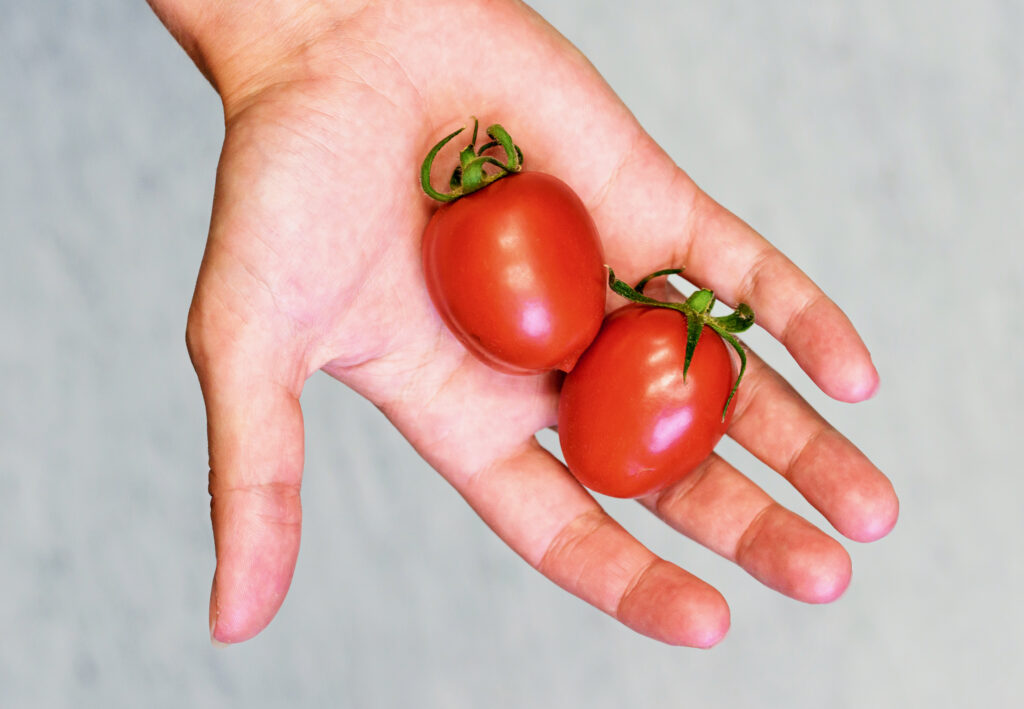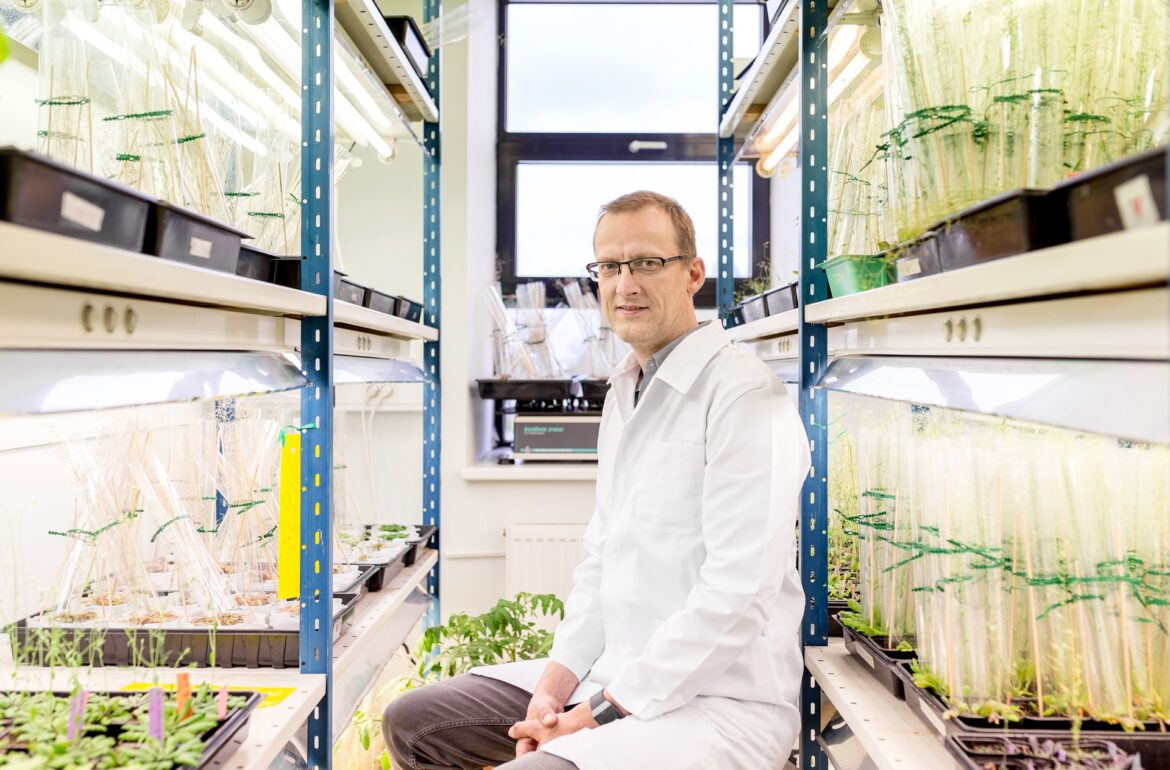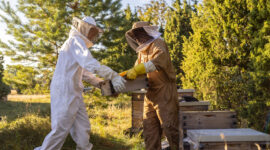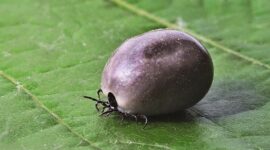“Non-genetically modified organisms do not exist,” says Professor of Molecular Plant Biology Hannes Kollist, who received this year’s national research award together with Associate Professor of Plant Biology Ebe Merilo for their work on plant adaptation under climate change.
The interview was originally published in Estonian in Universitas Tartuensis.
Climate is changing, and persistent drought is a growing problem worldwide. One way to reduce yield losses resulting from climate change is to breed more drought-tolerant and less water-intensive crops.
“Plants adapt to environmental changes by opening and closing the stomata in their leaves and stems. For example, the stomata close during drought to protect the plant from water loss and drying out. Carbon dioxide, however, is food for plants and the stomata open to admit it,” Professor Kollist explains. “We probably won the research award because we managed to describe the mechanisms of stomata closure in great detail. We showed which proteins trigger the processes, and how.”
Kollist became interested in gas exchange in plants as a doctoral student already: his doctoral thesis, defended in 2001 and supervised by Heino Moldau at the Chair of Plant Physiology, investigated how plants protect themselves from harmful tropospheric ozone.
Since 2007, Professor Hannes Kollist has led the plant biology research group at the Institute of Technology of the University of Tartu. He is currently supervising nine doctoral theses. On a more personal front, the professor loves travelling the world, competitive sailing, and engages in sheep farming in his country house in summer.
What fascinates you most about plant research?
Plants are very attractive objects of study because the scientist can test hypotheses ranging from molecular nuances to the functioning of the whole organism. It is comparatively easy to introduce changes in the plant genome and test the effect on the plant as a whole – this is not possible, or is much more complicated, with humans or even with many animals.
Plant science is a discipline of the future. It is crucial for solving humanity’s global challenges because plants provide us with food, valuable materials and renewable energy resources. For example, we might think: in a situation where we are clearly heading for a climate catastrophe if we carry on in the same way, should we channel our scarce scientific resources into research aimed at extending human life span or into the development of climate-resilient plants that require less fertiliser? Of course, this was a joke – we need both medical and plant scientists.
What is the stomatal opening and closing mechanism in plants for which you received the research award?
About 90% of a plant is water, so we could visualise plants as columns of soil water in the dry air. These columns are held up by structures made of cell walls. To survive in the dry air and not wither, the plant needs to hold water: the leaves are covered with a water-impermeable “skin” or cuticle.
The cuticle has air pores which, when open, allow water to move through the plant: from the soil, through the roots and stems to the leaves, also drawing up nutrients from the earth. The pores also need to open to let in carbon dioxide so that photosynthesis can occur, during which organic matter is synthesised, and oxygen is released, which animals, including ourselves, breathe. But if a plant keeps the air pores open too long, especially where the soil’s water reserves are diminishing, it can wither.
Also air humidity affects the process: the drier the air, the faster moisture is drawn out of the plant through the stomata. However, if you close the stomata fully, carbon dioxide cannot enter, and photosynthesis cannot take place.
In addition, transpiration (evaporation of water from plants – editor’s note) helps cool down the plant leaves. Interestingly, it happens similarly in humans: when it is hot, we sweat to cool down our skin with the evaporative heat of the water. The summer of 2021 was very hot and dry, and our students measured the gas exchange of plants in a wheat field at the Estonian Crop Research Institute in Jõgeva. It turned out that the temperature of wheat leaves was up to six degrees lower than the air temperature!
It seems like the plant has a brain with no self-awareness – a brain that constantly analyses external and internal conditions and responds accordingly.
(Laughing) Yes, you could say that. The guard cells that form the stomatal pores constantly process information, receiving signals from both the outside environment and the inside of the plant. The cells use such information to optimise the plant’s gas exchange so as to have enough food for photosynthesis. At the same time, they avoid the situation illustrated by the saying “Close your mouth, or your heart will get cold” – preventing excessive evaporation that could cause the plant to die.
But how is your work related to the breeding of drought-tolerant plants?
When you ask about yield loss due to plant stresses, the most common failures are due to plant diseases or, in other words, those caused by biotic stress. Globally, they account for 20–30% of yields.
However, in the case of abiotic stress – frost, drought, excess salinity, floods – yield losses can reach 60–70%. The goal of breeding plants that could cope better with drought is therefore highly justified.

After all, agriculture emerged in the Nile Valley and Mesopotamia, between the rivers of Tigris and Euphrates, in an area with no water shortage. This means that the low water consumption of agricultural crops was not important for millennia. The situation has now changed, and water shortage has become an increasingly acute problem due to population growth and climate change.
We studied the water use and growth of ecotypes of the model plant Arabidopsis, or thale cress, from different habitats. We found, for example, that the water use of the Cape Verde ecotype was more than ten times as high as that of the Portuguese ecotype. Still, at the end of the growing season, the biomass of both ecotypes was very similar. Thus, one ecotype consumed ten times more water to grow in the given conditions than the other, which means that there are significant resources for optimising the water use of plants.
Last year, when we also had a very bad drought in Estonia, PhD student Egon Meigas, our top expert in field measurements, studied wheat varieties. The results showed that wheat plants with better water use also gave better yields. Understanding these mechanisms allows us to breed varieties that cope better with drought.
How can plant genetics help make plants more drought-resistant?
For example, we have described a plant gene that encodes a regulatory protein kinase. If we introduce a specific type of mutation in this gene, the stomata will open about three times more. If we introduce a different kind of mutation, the stomata will be twice as closed. So, by means of point mutations within the same gene, we can either increase or decrease the plant’s water use efficiency. We can introduce such changes into plant cells using, for example, the bacterial immune system mechanism, now called the CRISPR-Cas technology. Currently, we are applying it to barley to create a water-efficient variety.
In this case, are they genetically modified plants?
By definition, yes. However, non-modified organisms do not really exist; the genomes of all organisms are constantly changing. I have used an example from a scientific article published a year ago: a newborn baby has as many as 50–60 new mutations, or genome changes, that neither the mother nor the father had. Over the lifetime, the number of these mutations increases. The DNA replication mechanism is quite foolproof, yet mutations occur naturally all the time.
As another example, Professor Detlef Weigel recently showed that if we consider the number of mutations that occur in a generation and the number of seeds that grow per one hectare of wheat, there is likely one mutation in every base pair in the wheat yield from one hectare. If we take a hectare of wheat with a yield of 10 tonnes, and there are about 20 seeds in a gram, there will be 4 × 1010 mutations. This, in turn, means that we are likely to have a mutation in each base pair in one hectare of wheat. These examples should illustrate that it does not really make sense to talk about modified and non-modified organisms.
The European Court of Justice has ruled that organisms modified by precision breeding technologies such as CRISPR, i.e. the so-called genetically improved organisms, must still be classified as GMOs. The decision has angered scientists, who argue that it will slow down the development of biotechnology for an entire generation.
Well, the European Union has already lost massive amounts of money earmarked for plant breeding. The development of this field is being done elsewhere: in the USA, Canada, South America and, increasingly more, in China, where rapidly growing startups emerge. Once again, there is no such thing as a genetically stable organism, an organism without genetic modifications.
The fear of GMOs probably stems from the fact that our knowledge in this area has developed very quickly. The cost of sequencing has fallen nearly a hundred thousand times over the last 20 years. As a result, our knowledge of changes in the genome and their relationship to the organism’s phenotype has grown exponentially. If this knowledge becomes more widespread, the unjustified fear of genetically modified organisms will disappear.
As a scientist, what is your view of the current climate processes?
Human-induced climate change is definitely a very serious problem. The levels of CO2 and other greenhouse gases are rising, and, unfortunately, so is the rate of their accumulation. It is as if we are accelerating towards an abyss.
We have been able to create machines that do a lot of work for us and transport us wherever we need to go in a matter of hours, but keeping these machines running requires the use of fossil fuels, the energy created by photosynthesis and stored in the ground. Firstly, the supplies are running out, and secondly, their exploitation over a very short period has produced excessive greenhouse gases and polluted the environment.
We need to prevent the depletion of natural resources and invest in sensible and realistic solutions. In this sense, the global green turn is essential. On the other hand, it must not be done in a rash or enforced manner. Europe’s economy and, ultimately, ordinary people must not be put under excessive pressure. It’s a question of finding the balance.
I am very concerned that the European Union has decided to spend a large proportion of its development resources on organic farming. Fewer chemicals in the fields, fewer pesticide residues in the food – there is nothing to discuss, we all support that! But without plant genetics and without the aim of improving the genetic resources of crops, promoting organic farming is of doubtful value.
The best and certainly the cleanest and greenest way to reduce the pollution burden from agriculture is modern plant breeding, which naturally involves improving plant genomes, cultivating new plant species and, if necessary, creating new plants by means of synthetic biology. However, the promotion of organic production leads to a decline in food production, and thus, EU’s dependence on other countries will increase. Advocates of organic farming are opposed to the use of modern biotechnology. This is not reasonable; moreover, it is harmful to the environment!
What is happening in Sri Lanka is a very telling example. Urged by anti-biotech activists, the government decided in 2021 to ban all fertilisers and chemicals in the fields of Sri Lanka. Agricultural production plummeted, and when the energy crisis and the coronavirus crisis came along, the country was essentially bankrupt; there is no stable government in place, there are street riots, etc.
What are the major challenges science is facing today?
Firstly, how to solve the global energy, material and food crises while preserving the natural environment around us in all its beautiful diversity. Secondly, how to disseminate education to every corner of the world as quickly as possible because education is the best way to slow down population growth.
What worries me is the increasing polarisation on issues that have already been scientifically resolved – such as GMOs or vaccines or, on a social level, the debate over abortion rights in the United States. This means that the role of universities and researchers in providing relevant evidence-based information to society is crucial. Now, in addition to doing research, we as scientists also need to develop our knowledge transfer and communication skills.
Written by: Tiia Kõnnussaar, UT Executive Editor
 Back
Back



